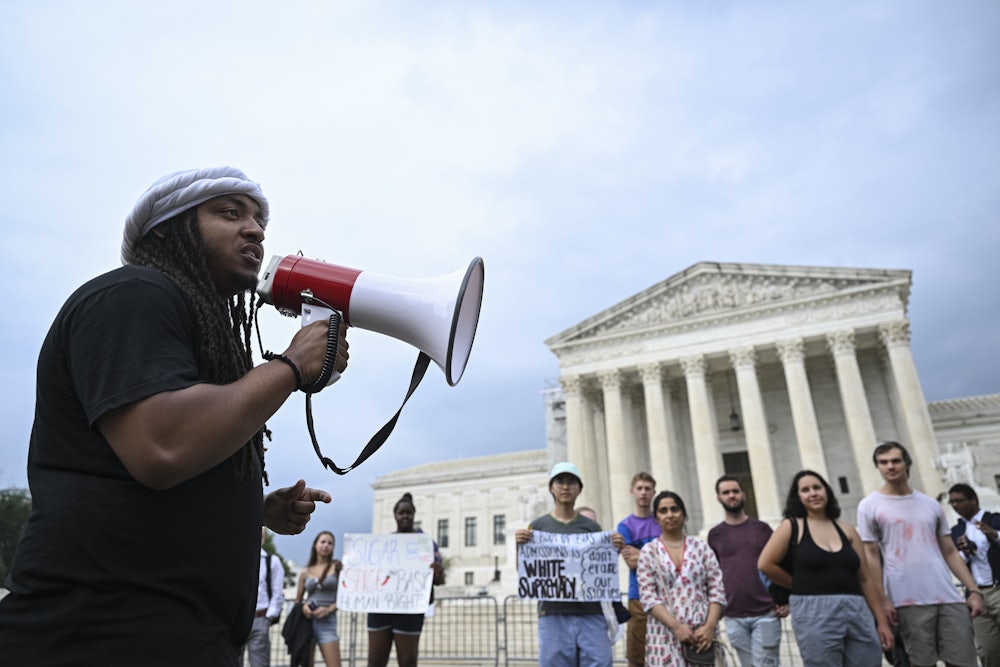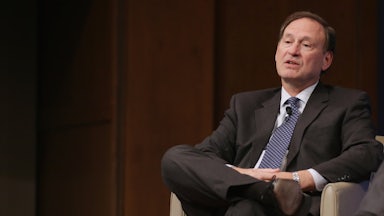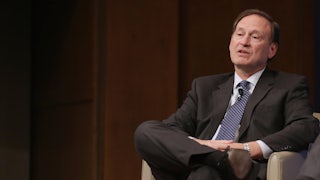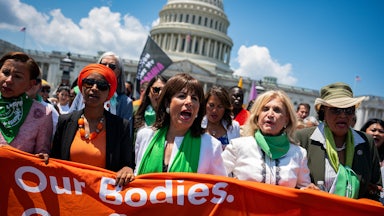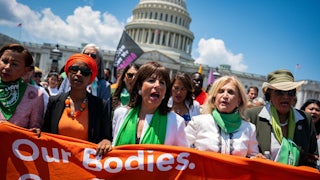If by interspersing unexpected liberal wins with expected wins for the right, Supreme Court Chief Justice John Roberts’s ploy was to confuse liberal critics, defuse their fervor, and brake the precipitous drop in the court’s public approval ratings, as many skeptics have inferred, then Roberts must be off for a pleasant summer. Liberals and Democrats have been all over the map trying to decipher the 2022–23 term’s mixed record. It’s an unenviable position to be in, but if they cannot get beyond this cacophonous chatter, they will squander vital opportunities to leverage the positive takeaways from the term—some widely noted, others largely overlooked—and in so doing regain traction in the ongoing war over the courts and the Constitution.
To summarize the left’s disparate take: On the one hand, voting rights advocates have echoed former President Barack Obama’s celebration of the Court’s 6–3 repudiation of North Carolina Republicans’ claim that the Constitution confers exclusive, uncheckable power on state legislatures to select presidential electors, free from constraint by state constitutions, judges, governors, or voters.
Obama hailed the ruling in Moore v. Harper as a “resounding rejection of the far-right theory that has been peddled by election deniers.” But other liberal court watchers demurred. Fordham constitutional expert Jed Shugerman tut-tutted that “the Roberts Court should get zero credit that [this decision] is any kind of moderation.” Shugerman laughed off the North Carolina politicians’ legal claim; because, as a matter of doctrinal logic and precedent, their asserted “independent state legislature theory” (also known as ISLT) was an “unthinkable possibility,” as paraphrased by Politico interviewer Josh Gerstein.
Even more “surprising” than the court’s rejection of ISLT was, as noted by columnist Jonathan Chait, a 5–4 majority’s “expansive” interpretation of the 1965 Voting Rights Act, or VRA, that “will create more Black-majority legislative districts in Southern states, which had been previously free to marginalize Black voters.”
Other voices on the left belittled these voting rights victories. Uber–Supreme Court pundit Linda Greenhouse sniffed, “Yes, democracy survived and that’s a good thing but, to settle on that theme is to miss the point of a term” that, overall, maintained full throttle for the right-wing majority’s drive to elevate conservative ideological and partisan goals over decades of judicial precedent, and constitutional and statutory text. Proponents of such cynicism had multiple examples to cite, like the conservative majority’s end-of-term extinguishment of affirmative action in higher education, its disallowance of President Biden’s express statutory authority to waive repayment obligations for millions of student loan recipients, and the erasure of the Environmental Protection Agency’s authority to safeguard wetlands under the 1972 Clean Water Act.
But then again, some liberal experts disputed the importance of these high-profile losses. The Washington Post’s Jennifer Rubin dismissed “the right’s affirmative action victory” as “empty.” In Roberts’s decision, she wrote, “What he takes away with one hand he immediately gives back with the other;” pointing to his caveat that “nothing in this opinion [prohibits] universities from considering an applicant’s discussion of how race affected his or her life … through discrimination.”
Everyone involved in these squabbles among allies is making a common, fundamental mistake. Instead of obsessing about Roberts and his allies’ sincerity this past term—or their future intentions—liberals’ principal focus should be trained on themselves. Their overriding concern should be on what the results, good and bad, owe to their own legal, communications, and political strategies. Most important, liberals need to work out what such no-nonsense assessments might mean for their own agendas going forward.
It would be a bad idea to ignore or dismiss—as insincere or inevitably short-lived—the plusses registered in this Supreme Court term. Trivializing the court’s positive actions as politically motivated calculation is the line their right-wing adversaries take. Liberals and Democrats should defend those decisions as legally solid precedents, to entrench and build on.
The first step is to identify and scope out the value of those positive results and takeaways. Importantly, such measurements cannot be made against nostalgic notions of some idealized mid-twentieth century Warren-Brennan Court’s constitutional regime, or a future delusional nirvana. The upshot of this past Supreme Court term must be measured against realistic benchmarks: previous portentous signals from rightist justices; extreme theories expounded by right-wing activists and savants, lauded by influential Republican politicians and rightist judges and justices. And again, critically, to probe which of this term’s positive outcomes could be attributable to liberals’ advocacy—what worked and what didn’t.
Let’s start with the obvious liberal victories: the two election cases. President Obama was spot-on to extol Moore v. Harper, North Carolina Republican legislators’ failed attempt to block judicial oversight of their reversal of voter preferences. Professor Shugerman and other liberal skeptics may now dismiss ISLT as “unthinkable.” But, prior to the decision, four conservative justices, including Roberts, signaled receptivity to considering the theory as entirely thinkable. By interring the theory, Chief Justice Roberts executed a transparent volte-face.
His opinion relied on a 2015 5–4 Supreme Court decision upholding, against an ISLT-based challenge to a referendum authorized by Arizona’s constitution that established a commission to determine congressional redistricting, rather than the state legislature; that 2015 decision was adopted over a vehement dissent by Roberts himself. Revisiting the issue eight years later, Roberts reaffirmed the prior holding which he had elaborately disputed; most telling, he associated himself with the 2015 majority’s “core principle ... that redistricting is a legislative function, to be performed with the State’s prescriptions for lawmaking, which may include the referendum and the governor’s veto.” (Emphasis added.) Liberals should proclaim Court’s embrace of that “core principle” from the rooftops.
True, Roberts’s opinion for the court, and Justice Kavanaugh’s concurring opinion, stated that, although [the reference to state “legislatures” in the federal Constitution’s Election Clause] does not exempt state legislatures from the ordinary constraints imposed by state law, state courts do not have free rein,” and the clause empowers federal courts, including the Supreme Court, “to undertake an independent, if still deferential, analysis of state law” to ensure that “state courts not transgress the ordinary bounds of judicial review.” You can expect Republican state legislators and their allies to seize on that qualification, the better to bloat this exception to swallow the rule. But liberals should not be giving aid and comfort to their adversaries’ spin. They should be preparing to bat down attempts to marginalize the “core principle” of a foundational landmark precedent reaffirming the framers’ design for a genuinely democratic (small “d”) republic, with wide latitude to “guarantee,” as the Constitution expressly prescribes, to state governments flexibility to determine the contours of democratic decision-making.
As for the second unexpected voting rights win—the Alabama redistricting case, Allen v. Milligan—no observer disputes that Roberts executed an apparent 180. Dating back to his tenure with the Reagan White House and Justice Department, he had etched an unbroken record redolent with hostility to the VRA. As Chief Justice, in decisions in 2010, 2013, and 2021, Roberts had, as observed in a fierce 2021 dissent by liberal justice Elena Kagan, repeatedly “rewritten” the VRA, with his “own set of extra-textual rules,“ in order “to weaken a statute that stands as a monument to America’s greatness.”
But in Milligan, Roberts struck an audibly different chord. He lauded the VRA for “creating stringent new remedies attempting to forever banish the blight of racial discrimination in voting … the most successful civil rights statute in the history of the nation.” He approved the District Court’s order that Alabama must redraw its districting map to include not one but at least two predominantly African American districts, because, Roberts wrote, “the question whether additional majority-minority districts can be drawn, after all, involves a quintessentially race-conscious calculus.” (Emphasis added.)
In engineering these surprising voting rights outcomes that, as widely noted, favored both democracy with a small “d” and Democrats with a capital “D,” Roberts appears to have responded to three related recent lines of attack arising from liberals’ incipient awakening to the existential threat posed by this Court. The first is the charge that the Republican super-majority has not only been injudiciously activist, but partisan. That critique has been leveled by Democratic politicians, long cowed into turning the other cheek, including Senate Judiciary Committee Chair Dick Durbin, and led by Roberts’s glib and media-savvy liberal colleague Elena Kagan’s barb that “the court shouldn’t be wandering around just inserting itself into every hot button issue in America, … especially, in a way that reflects … one … set of political views over another.” (Emphasis added.)
In addition, it seems noteworthy that in these cases, Roberts—who has disclaimed strict fidelity to the conservative interpretational credos “originalism” and “textualism”—underscored meticulous adherence to the text of relevant statutory and constitutional provisions, and the pro-democratic designs of the constitutional framers. This approach could well be attributed to sharp criticisms by Justices Kagan and Jackson.
Roberts’s deference was not necessarily owed to the fact that these were the criticisms of colleagues. It’s actually more likely that their invocation of legal text and framers’ goals sparked widespread media attention. Related to both these criticisms—pro-Republican partisanship and disdain for textualist/ originalist guardrails—Roberts certainly has in mind a third front opened by critics, namely, that they have channeled these (along with other) indicia of illegitimacy into demands for an enforceable code of ethics for the court.
Additionally, the absorption of popular concerns about charges of injudiciousness and partisanship was a lower-profile but, potentially equally significant course-correction for the court’s right wing bloc. This involved the super-majority’s rampant abuse of a once rarely used procedure reserved for genuine emergency situations—the issuance of curt, often one-paragraph or even one-sentence, unsigned, unexplained orders, without undergoing full briefing and argument.
Originally called the “shadow docket,” in 2015, by conservative Chicago law professor William Baude, this process has more recently been called out by Texas professor Stephen Vladeck as an “obscure” gambit “used … over and over … to shift American jurisprudence definitively to the right … in a manner that appeared transparently political, if not overtly partisan.”
In September 2021, Justice Kagan picked up the Baude–Vladeck “shadow docket” label, and in good time Roberts began joining the liberals in dissent against his five right-wing colleagues’ serial abuse of the procedure. But in the first months of the 2022–23 term, Justice Kavanaugh added a fifth vote, along, possibly with others, for shelving, or at least slowing the right’s shadow docket conveyor belt. In late December 2022 Bloomberg’s Senior Supreme Court Reporter Lydia Wheeler spotted this trend, suggesting that “the justices could be signaling they no longer have the same appetite to settle fights by way of an emergency order.” Vladeck concurred, as did other experts, such as Michigan professor Leah Litman, who wrote, “I think they are responding to pretty forceful criticisms about the activity on the shadow docket.”
Even less noted than the Court’s apparent retreat from shadow docket overreach was a more consequential decision: a June 8 case, Health & Hospital Corporation of Marion, Indiana v. Talevski. In this ruling, a 7–2 majority rejected an attempt to disembowel the federal government’s capacity to tie regulatory strings to funds granted to states and localities. Conservatives have long recognized that, as libertarian Texas Law professor Lynn A. Baker spotlighted as early as 1995, “the greatest threat to state autonomy is, and has long been, Congress’ spending power.” (As distinguished from the far more touted authority to “regulate” interstate commerce.) From time to time, right-wing academics, advocates, Republican (and, sometimes, Democratic) state attorneys general, and, on occasion, as many as four Supreme Court justices have come up with legal theories to act on Baker’s insight, and cripple this “conditional spending power.”
But none of these legal hand grenades ever garnered five votes. In Talevski, Indiana’s attorney general decided that the new Trump super-majority might have removed that wall. He claimed that Medicaid, and other conditional spending clause programs, could not be enforced in court by individual victims of state governmental violations of grant requirements. Such individual lawsuits, under Section 1983 of the Reconstruction era Ku Klux Klan Act of 1871, have always been the only effective means of securing state compliance with requirements in laws as important as Medicaid (covering over one quarter of the national population), Medicare, civil rights protections such as the 1964 Civil Rights Act and the gender equality in athletics strictures of what is known as Title IX, key provisions of the Clean Air and Clean Water Acts, and many other landmark liberal laws.
But, to Indiana’s challenge, Chief Justice Roberts assigned liberal rookie Justice Ketanji Brown Jackson to write (her first) opinion for the court, which crisply repudiated Indiana’s claim that spending clause conditions were not within the meaning of federal “laws” protected by Section 1983. ”Hewing to text and history, … our precedent and constitutional role,” Jackson wrote, “we reaffirm, that ‘laws’ in Section 1983 means what it says.”
Only Justice Clarence Thomas, whose dissent decried “the ubiquity of such spending conditions … spanning virtually every domain of national and state policy … combined with the Federal Government’s overwhelming financial heft,” seemed eager to take up far-right ideologues’ ambition of taking down this “extraordinarily potent instrument of federal control”—although Justice Alito’s narrower dissent and Justice Gorsuch’s concurring opinion hinted at future, more circumscribed cavils. But overall, the decision makes the conditional spending foundation for much of modern liberal governance seem secure. That is a prospect worth noting—and worth highlighting to ensure it stays that way.
Finally, it is self-destructive for liberals to pooh-pooh the qualifications that Roberts and other conservative justices wrote into high profile liberal losses. Instead, liberal leaders should spotlight those concessions and prepare the ground to better exploit them. For example, take the above-mentioned exception noted by Jennifer Rubin to the court’s axing of affirmative action. Indeed, Princeton University professor Paul Starr, a founding editor of The American Prospect and no one’s idea of a conservative, saw that as a positive opportunity, potentially “open[ing] a new era of affirmative action that serves many of the same purposes but enjoys more political support and a stronger legal defense.”
Starr focused on the Chief Justice’s instruction that college admission policies could provide “[a] benefit to a student who overcame racial discrimination [that is] tied to that student’s courage and determination [but] the student must be treated based on his or her experiences as an individual—not on the basis of race.” Significantly, Starr lauded, as “exactly right,” President Biden’s response to the decision.
In his press conference the afternoon of the blockbuster ruling, Biden proposed a “new standard”—that “colleges take into account the adversity a student has overcome when selecting among qualified applicants.” (Emphasis added.) Biden elaborated that such an adversity-centered approach would mean “understanding the particular hardships that each individual student has faced … including racial discrimination that individuals have faced in their own lives.” Universities and colleges that wish to continue promoting diversity would be well advised to deploy Biden’s “adversity” approach—and it has been reported that many already are doing just that.
Biden’s studied legal and political exposition of a doctrinal “standard” carries significance well beyond the affirmative action issue. In effect, he is emulating liberal icons such as Lincoln and FDR, by asserting that the president has a critical role, rivaling the justices themselves, in driving what Yale law professor Akhil Amar has labeled the national “constitutional conversation” to determine, in Chief Justice John Marshall’s words, “what the law is.” As we see with the aforementioned rhetorical foray Biden offered in the immediate aftermath of the affirmative action decision, it’s possible for the president to have an immediate, direction-setting influence, potentially mitigating real-world effects and damaging subsequent interpretational trends.
More broadly, liberals should give themselves due credit for the unexpected good news (or if you prefer, the not-so-bad news) from the Supreme Court’s recent term, however partial and flanked by expected dark defeats. At all levels—as justices, judges, politicians, pundits, activists, and voters—liberals are entering what was for decades a one-sided, right-tilted political conversation about what the Constitution and laws mean. And the court—which, as Alexander Hamilton famously called the “least dangerous branch, possessing neither force nor will, but merely judgment,” requiring public respect for compliance with its rulings—is paying attention. This is not a time for downcast doubts: Liberals need to keep it up and amp it up, the better to make inroads in the many battles that lie ahead.
